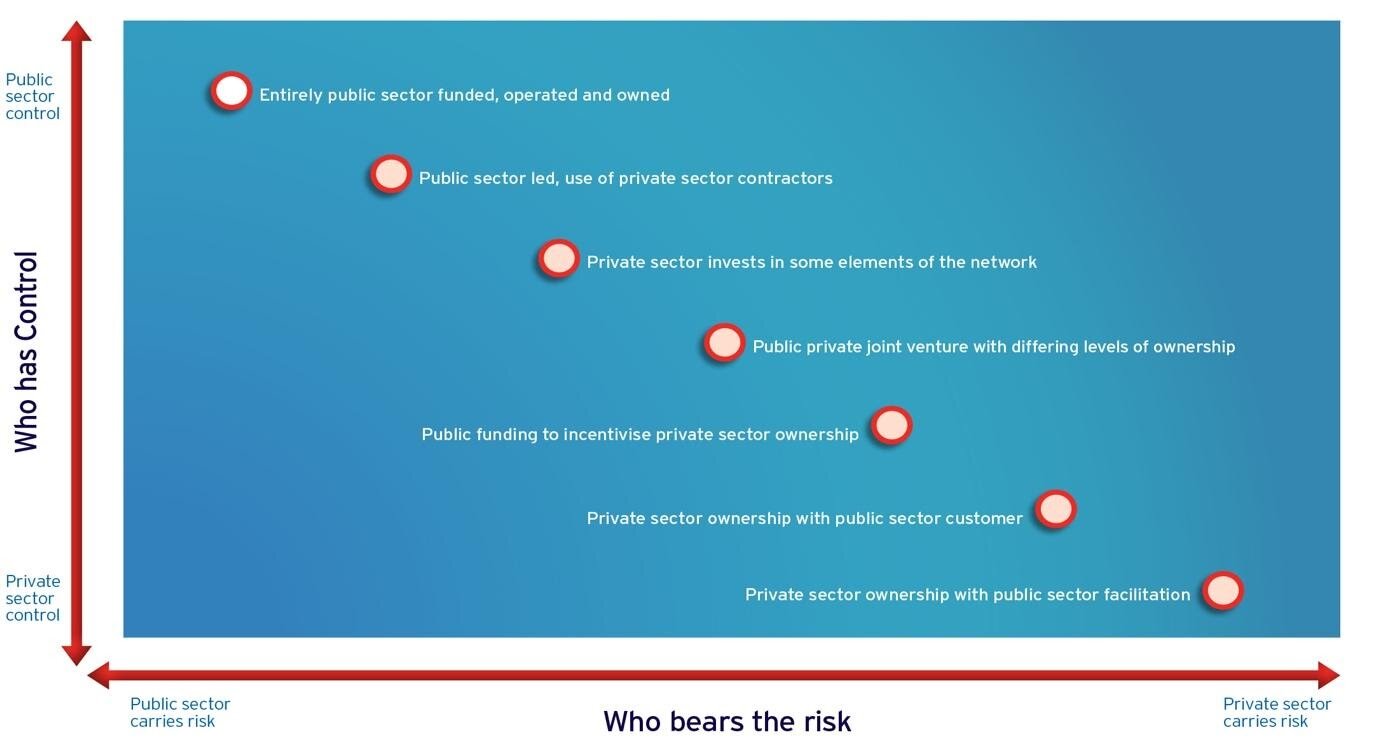Delivery structure options
There are a range of delivery structure options for heat projects, ranging from fully owned and operated by the public sector to fully owned and operated by the private sector, with finance options also ranging across this divide. These are illustrated in Figure 1, below, and each has a different risk profile:
Figure 1 Commercial structure options (source DECC(note 1), public sector information licensed under Open Government Licence v3.0 www.nationalarchives.gov.uk/doc/open-government-licence/).
In considering the most appropriate structure, it is important to recognise that risk generally goes hand in hand with control: the more control required, the more risk must be accepted. Conversely, a risk-averse approach is likely to result in some loss of control over the ability to achieve identified strategic objectives.2 DECC’s Investor guide to Heat Networks3 includes the following graphic illustrating the relationship between control and risk.
Figure 2: Relationship of control to risk (source DECC (note 4), public sector information licensed under Open Government Licence v3.0 www.nationalarchives.gov.uk/doc/open-government-licence/).
Heat Supply Options
In the UK, there are typically two business model approaches that Energy Service Companies (ESCo’s) supplying heat follow. These are Energy Performance Contracts (EPC) and Energy Supply Contracts (ESC), which can be utilised separately or together. The third model, most often used in continental Europe, is Chauffage contracts. They all focus on energy efficiency and cost savings, rather than kWh or units of heat. Of course, it is possible to simply supply units of heat, using a heat meter to measure supply.
Energy Performance Contracting (EPC)
There are two common forms of EPC, guaranteed savings and shared savings. Under the guaranteed savings model, the customer finances the project and the ESCo will guarantee a minimum energy savings level. Any savings exceeding this level are then split between the ESCo and the customer. With shared savings, the ESCo finances the project and the savings are then split between the customer and ESCo according to a predetermined split.
EPCs are suited to large scale projects, particularly in the public sector, because the savings guarantee makes it a safe investment. In many cases, EPC projects generate 20 - 30% energy savings and the contract times are generally around 10 - 15 years. The EPC is a complex contract with high transaction costs, which in many ways make them less suitable for smaller projects. In addition, the often-long payback times make it less attractive.
Energy Supply Contracting (ESC)
Energy Supply Contracting is a supply side energy efficiency measure and ensures delivery of useful energy, referring to energy that a customer has ‘practical’ use for, such as heat, cooling or steam, as opposed to energy carriers such as oil or biomass fuels. The ESCo would take on the responsibility for everything needed to deliver useful energy to the customer. For example, in the case of heat this could include planning and installation of boilers, energy distribution, operation and maintenance or production facilities and the procurement of fuel.
ESCs are often oriented toward decentralised power supply. In most cases ESC is investment free for the customer and the contracts typically run for 10-15 years. The energy efficiency measures are taken on the supply side to ensure lower cost of operation, which often amount to 10-20%.
Chauffage
Chauffage contracts, also referred to as ‘comfort contracting’, are used frequently in continental Europe and are a more extreme form of energy management outsourcing. It is a contract form that revolves around providing a function, with the ESCo typically taking complete responsibility for the provision of an agreed set of energy services, for instance space heating. The function can be related to temperature, lighting level, air quality etc. A common example is providing a certain (or relative) temperature of a building, for example maintaining a temperature of 21°C.
Compared to EPC, these contracts are less complex with lower transaction costs and without the need for costly measurement and verification. The EPC’s may have more comprehensive demand side energy efficiency measures reaching a wider range of areas and may be better suited for larger building pools. The Chauffage model works especially well in the commercial buildings sector.
Integrated Energy Contracting (IEC)
IEC is a business model that combines elements from both ESC and EPC, with the aim being to involve both supply side and demand side energy efficiency measures. The business model of integrated energy contracting is normally based on the standard Energy Supply Contracting model, whereby the ESCo will get remuneration for the useful energy delivered, as well as a flat rate service remuneration for operation and maintenance.
Footnotes:
DECC, Investing in the UK’s Heat Infrastructure: Heat Networks, November 2015
Scottish Futures Trust, Guidance on Delivery Structures for Heat Networks, March 2015.
DECC, Investing in the UK’s Heat Infrastructure: Heat Networks, November 2015
DECC, Investing in the UK’s Heat Infrastructure: Heat Networks, November 2015


